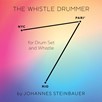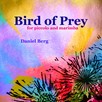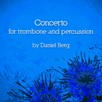
Across Heaven - Beyond The Clouds
Composer: Daniel Berg
Instrument: Vibraphone and Organ
Level: Advanced
Published: 2023
Price: €35.00
Item details
-
Description +
-
In 1962, the Swedish poet and Nobel laureate Tomas Tranströmer published his collection of poems the Half-Finished Heaven. Here there is both uncertainty and a quiet melancholy about opportunities we never see and take, but at the same time a simple joy and an obvious sense of freedom expressed in heartbreaking images and an incredible linguistic tension.
When the artist Peter Christensson heard Daniel's new work for vibraphone and organ, he saw a green sky envisioned, but what’s behind the clouds? This is precisely what is central to art, poetry and music – to describe and portray the unpredictable and enigmatic – a quiet sadness over opportunities we never see and take, but at the same time a joy and obvious sense of freedom expressed in creation.
Comment regarding organ registration:
In the first part of the piece, it is important that the registration is clear in order to facilitate rhythmic accuracy and is transparent without becoming too thick. The basic idea can be principals 8, 4, 2 with the addition of some aliquot stops (fifths or possibly thirds). If the principal timbre becomes too thick, it can make it easier to build the timbre on flute parts in the same foot number.
The same registration applies to the final part including the coda – possibly with the addition of mixture timbre in the manual and reeds in the pedal. In the pedal it is the same principle, however, if the pedal is powerfully registered and possibly disconnected, you can possibly exclude some of the octave parts in the pedal.
In the middle part, it fits nicely with double 8-foot parts of a soft and preferably stroking character. The pedal can easily be registered with 16- and 8-foot parts of a labial character – aim for a sound like a double bass!
Johannes Landgren
-
-
Instrumentation +
-
Vibraphone and Organ
-
-
Watch+
-
Performance by Johannes Landgren (organ) & Daniel Berg (vibraphone)
-
-
About the composer +
-
Daniel Berg is a Swedish composer, musician, and professor in classical percussion at the Royal College of Music in Stockholm and at the Academy of music and drama in Gothenburg.
In his passion to promote the marimba as a solo- and chamber music instrument, Daniel has worked intimately with a number of composers who have written original music for the instrument. This includes more than 300 world premier for solo and chamber works. Daniel Berg is a marimba artist of Bergerault and Elite Mallets.
As a composer Daniel has written a lot for solo marimba like Mistral (for Michael Burritt), Phoenix (for Robert van Sice) and Yán Jiâng (for the Taiwan World Percussion Competition). His music for percussion ensemble have been appreciated and often performed like Kroumata (for sextet) and Arctic Nights (for quintet) - all published by Edition Svitzer.
-
-
Reviews +
-
Review (Percussive Notes, June 2024)
It is not often that we come across a piece that includes an organ. The vast possibilities of timbres when working with this magnificent instrument are nearly endless. Daniel Berg gives us such a collaboration with his new duet for organ and vibraphone. The two instruments blend well together in the dissonant soundscape that Berg creates.
The program notes refer to a collection of poems titled The Half-Finished Heaven by Swedish poet Tomas Transfrömer. Berg states about this collection the inclusion of “uncertainty and quiet melancholy” as well as “simple joy [and] freedom expressed in heartbreaking images.” His reference to Transfrömer’s work helps explain the prevailing use of diminished and dissonant harmonies throughout the piece, which counters the sacred sounds that most would expect from something titled after the Promised Land.
The outside portions of the work represent the “uncertainty” that Berg describes. He does this in how he uses harmonies and meters. All the chords that are blocked by either instrument or spelled out in melodies are fully diminished in quality, or they make up a cluster that increases the ominous atmosphere. Berg also cycles through four different time signatures, some sounding simple while others sound compound, to increase tension where necessary. Each player shares the role of accompanist and lead voice at different times, alternating between blocking out the clustered harmonies, playing the perpetual sixteenth-note melodic material, and playing in unison at cadence points.
The middle sections are where we get to hear the “simple joy.” Once the menace of the diminished sonorities subside, and all that is left is a C pedal from the organ, the vibraphone is given the opportunity to play freely. Here, the percussionist is given sweeping gestures up and down the instrument in much more diatonic sonorities. Even though the player is given brisk and advanced rhythmic figures, such as quintuplets and thirty-second notes, the instruction here is to play without a sense of pulse, and to even ad lib figures around given chord structures. All of this gives the antithesis of the strictly composed and diminished harmonies of the previous section.
Berg has created a unique piece to present the audible representations of “unpredictability” and “simple joy.” The dissonant soundscape that is created between these two instruments are eerily beautiful and present a tempting challenge to any players who wish to take it on.
—Kyle Cherwinski
-
-
Credits +
-
Artwork: Peter Christensson
Photo (Daniel Berg): Jon Liinason
Cover: Nicola Lee
Printed in Copenhagen, Denmark
Copyright © Edition SVITZER
www.editionsvitzer.com
-









